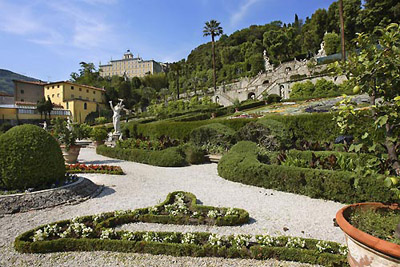
What is a Italian Renaissance Garden?
A Renaissance Garden is a place for retreat from a hectic world. It’s for pleasure and peace. It’s for wandering, pottering and contemplating. Any practical elements such as vegetables, fruit and herbs are woven into the garden design so they appear ornamental.
Outlining with Evergreens
The most recognizable elements of the Classical Italian Garden are the evergreen-outlined beds. Boxwood hedges, myrtle, rosemary, and other evergreen plants are trimmed into a hedge shape to divide the beds. More importantly, however, the hedges provide shape and green even in the garden’s fallow months because the Renaissance Garden is meant for year-round pleasure.
Topiary and Statuary
Topiary, evergreen plants shaped, trimmed and pruned into amusing shapes, are used to add humor and playfulness to the garden. Some say this is really a medieval custom that just stayed on during the Renaissance. But you’ll see more topiary than statuary in Classical Italian Gardens. Statuary, when it is used, is normally a central feature in a fountain or grotto. It is never vulgar or offensive, but humorous or graceful.
Fruit Trees
Renaissance Garden fruit trees are clipped and well tended. Some are planted in pots; others are planted in open ground, most often against walls. Citrus fruit plants are often potted up so they can be set outdoors during warm months, and moved indoors during winter months. Other fruit trees are usually trained as arches or over pergolas, when they’re not formed as an esplanade against a South-facing wall, for early ripening of the fruit.
Arches and Pathways
Evergreens often line pathways, and it’s not always box hedging. Laurel, Yew, Cypresses, Fir, Oaks, Plum, and Juniper trees are used to create green walls, arches and living pergolas. Footpaths are designed to offer varied walks with varied views through the garden. Paths can be grass paths, mown down regularly, or dirt paths weeded regularly or gravel-covered.
Trellises and Climbing Plants
Trellises are used to divide “rooms” and line paths in the garden. They are trained with climbing plants like ivy, roses, honeysuckle, or grape vines. The climbing plants are also trained over structures such as pergolas, porticos and pavilions. Flowering climbers are preferred.
Terracing
The ideal Renaissance Garden is terraced on a gently sloping hillside. Paths and short flights of steps join the various levels. Terraces are used mainly to divide the garden into “rooms” with varying “moods”, and to limit the views and vistas. A connecting terrace should come as a surprise when climbing up the garden. Looking down from the villa, however, the terraces should create a tableau of pleasing vistas, artistically sculpted views.
Potted Plants
Terra-cotta pots, often covered with figures and designs, are common decorative features in Renaissance Gardens. Flowers, fruit trees and herbs can be potted up and moved around the garden for variety and added color. They are almost always displayed in balanced symmetry.
Tightly Planted Beds
Bordered beds are often planted up on various eye levels. In the center is a tall plant such as a fruit tree, or an evergreen such as Laurel. Surrounding the tall plant are shorter plants in a different color, providing either a contrast or a complementary shade. These plants are often herbs or flowering plants such as roses, salvias, or lupines.
Water Features
Water always plays a part in Classical Italian Gardens. Primarily the water is for irrigation to keep the plants from drying out. Secondarily, the water is used for features such as grottos, fountains, streams, and ponds. These features can be central features in “rooms”, or as in the case of grottos, off to the shady sides of the garden.
Planned with the Villa
The villas were always taken into account when planning a Renaissance Garden. The villa is treated as a feature of the garden, usually the central view. Shapes on the exterior and interior of the villa are often mirrored in the garden shapes and structures, creating a harmonious blend of the two. But just as important are the beautiful vistas from the Villa when looking out of the windows and doors into the garden.
Structures
Structures are used to separate “rooms”, add varied heights for views; and to provide shade, relaxation, and protection from wind and salty sea-air. These structures can be porticos, pergolas, pavilions, grottos, loggias, balustrades or walls. They are made of natural materials and often trained with climbing plants.
Garden Furniture
Seating is spread around the garden so the various vistas and “rooms” can be contemplated and enjoyed in repose. Seating can include benches, small patches of lawn for picnics, chairs, and tables with chairs. They are usually in natural materials such as stone and wood. Covered seating areas are normally provided for protection from sun and rain alike. Pergolas covered in vines or flowering plants are a typical covered structure.
The General Mood
The Renaissance Garden or Classical Italian Garden is a light, open, peaceful, symmetrical, soothing garden. There is nothing dark, melancholy or gloomy.
